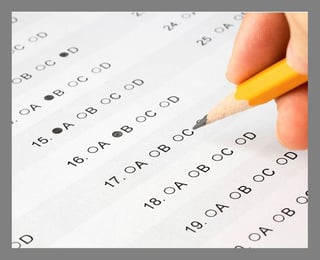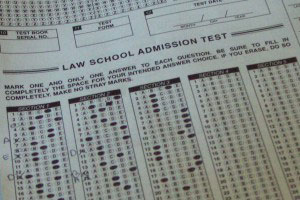In order to truly master the logical reasoning section on the LSAT you must first master the different types of questions that you may encounter. Learning to identify...
Law School News and LSAT Strategy
Stay current with the latest law school admissions news and proven LSAT strategies.
Posts about Getting in to Law School (4):
LSAT Tip of the Week: It's All About the Bubble
 The LSAT is famous for its tight timing. Check out this timer by Alpha Score to practice your timing. Surprisingly enough, the way you bubble your answers on the LSAT holds some importance. You have to use every second to your advantage. Although it may seem counterintuitive, bubbling in bulk will actually save you precious time. As you work your way through a section, circle your answers in the test packet itself. When you reach the end of a page, turn to your answer sheet and fill in answers for that page in bulk. This way you are not wasting time moving between the test booklet and your answer sheet. Of course, you have to be very careful to pay attention to which bubble you are filling in and if it correspond to the answer you circled. When you have about five minutes left, start bubbling answers one at a time, even the questions you are skipping. If you skip a question, make note of it by making a light dash mark by the number, but fill in a bubble regardless. This is just in case you run out of time before you have time to go back and address it. A total guess is always better than a blank!
The LSAT is famous for its tight timing. Check out this timer by Alpha Score to practice your timing. Surprisingly enough, the way you bubble your answers on the LSAT holds some importance. You have to use every second to your advantage. Although it may seem counterintuitive, bubbling in bulk will actually save you precious time. As you work your way through a section, circle your answers in the test packet itself. When you reach the end of a page, turn to your answer sheet and fill in answers for that page in bulk. This way you are not wasting time moving between the test booklet and your answer sheet. Of course, you have to be very careful to pay attention to which bubble you are filling in and if it correspond to the answer you circled. When you have about five minutes left, start bubbling answers one at a time, even the questions you are skipping. If you skip a question, make note of it by making a light dash mark by the number, but fill in a bubble regardless. This is just in case you run out of time before you have time to go back and address it. A total guess is always better than a blank!
LSAT Tip of the Week: Understanding the Author's Premise
 The Argument Section on the LSAT requires a brain in critical thinking mode. This article by Magoosh outlines why it is such an important section. You must be able to identify the author’s conclusion, or the point they are trying to make, as well as the evidence used to support that argument. In this article we will focus on the evidence, also called the author’s premise. Let’s consider this example:
The Argument Section on the LSAT requires a brain in critical thinking mode. This article by Magoosh outlines why it is such an important section. You must be able to identify the author’s conclusion, or the point they are trying to make, as well as the evidence used to support that argument. In this article we will focus on the evidence, also called the author’s premise. Let’s consider this example:
LSAT Tip of the Week: Understanding the Author's Conclusion
The Argument Section on the LSAT requires a critically trained brain. Most importantly, you must be able to identify the author’s conclusion, or the point they are trying to make, as well as the evidence used to support that argument. In this article we will focus on the conclusion. Stay tuned for next week's tip on identifying the author's evidence, or premise.
LSAT Tip of the Week: How to Read an Argument
The Argument Section of the LSAT, also known as the logical reasoning section, is made up of 24 to 26 arguments. Helpful LSAT course sites like 7Sage usually include an...
LSAT Tip of the Week: Logic Games
 With the new year comes new habits, and create these new habits around how you will approach and attack the LSAT. This week, spend a few hours each day reviewing logic games. This section can seem daunting to some, but in reality it is the easiest to master if you just can get a little faster at them and master the rules. Through some trial and error, here is what I found to be the most efficient way to complete a logic game. Two overarching ideas to keep in mind: (1) stay organized and (2) write legibly. Nothing is more frustrating than trying to decode your own handwriting and thoughts while already facing something as mind-consuming as a logic game. First, read the question and then diagram on the right side of the page where the individual questions are. This will save you precious time from scanning back and forth. Make sure you label the diagram you create for each question as well, helping you stay organized, and ensuring they are not too large or complex. The biggest tip to remember though is to simply memorize the rules. The LSAT questions, minus a few outliers, follow a set fact-pattern and rule that has been established already. Spot these rules, memorize these rules, and know them like the back of your hand. Keeping all of this in mind you can make the logic games your best section in no time.
With the new year comes new habits, and create these new habits around how you will approach and attack the LSAT. This week, spend a few hours each day reviewing logic games. This section can seem daunting to some, but in reality it is the easiest to master if you just can get a little faster at them and master the rules. Through some trial and error, here is what I found to be the most efficient way to complete a logic game. Two overarching ideas to keep in mind: (1) stay organized and (2) write legibly. Nothing is more frustrating than trying to decode your own handwriting and thoughts while already facing something as mind-consuming as a logic game. First, read the question and then diagram on the right side of the page where the individual questions are. This will save you precious time from scanning back and forth. Make sure you label the diagram you create for each question as well, helping you stay organized, and ensuring they are not too large or complex. The biggest tip to remember though is to simply memorize the rules. The LSAT questions, minus a few outliers, follow a set fact-pattern and rule that has been established already. Spot these rules, memorize these rules, and know them like the back of your hand. Keeping all of this in mind you can make the logic games your best section in no time.
